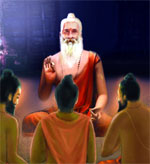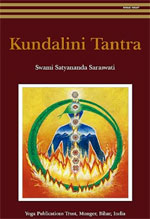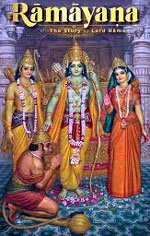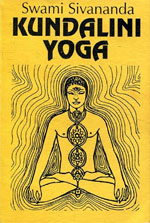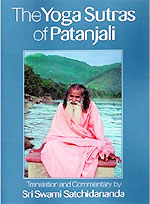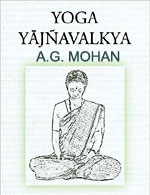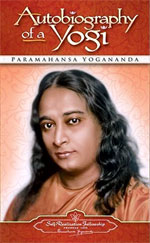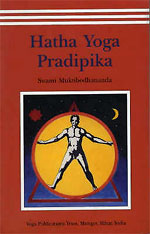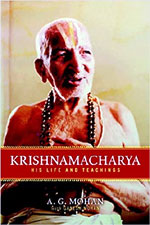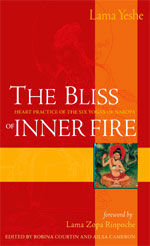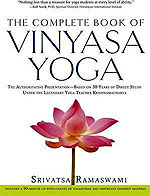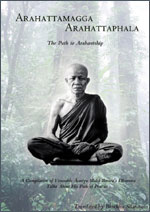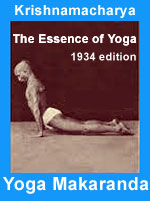

Upanishad Series
Upanishad Series
The Upanishad is a collection of ancient Hindu philosophical and metaphysical text that talks about the nature of reality, self and consciousness. It takes the format of a teacher-student discourse. The Upanishads are found at the end of each Veda and represent a shift from external rituals and ceremonies to the exploration of inner spiritual knowledge and philosophy. The aggregate number of the Upanisads comes to 1180, but only 108 survives. It branches into 10 legs, some of them as follows:
Yoga Book Reviews
YOGA Book Reviews
FREE online books
BooksFree.org | Project Gutenberg | Open Library | ManyBooks | Free-eBooks.net | Bookboon | Smashwords | PDFBooksWorld | PDF Drive | Google Books
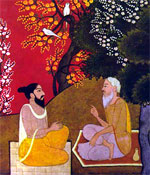 December 12, 2023
December 12, 2023
Yoga Upanishad
What is the Yoga Upanishad?
The Yoga Upanishad is a collection of ancient philosophical and poetic Sanskrit verse describing mystical states and spiritual concepts about the principles and practice of yoga - meditation, breath control (pranayama), and subtle energy channels (nadis). Of the 108 extant Upanishads, 20 of them are considered Yoga Upanishads. But the list of 20 Upanishads vary depending on the scholar and the tradition. Thus, it's confusing, so I gathered most of them, exceeding 20 in total. I chose the listing by Google Bard AI. Under the 108 Upanishad umbrella, Yoga Upanishad shares common themes such as the pursuit of knowledge, the importance of a guru, the inquiry into the nature of reality, and the recognition of a transcendent, ultimate reality beyond the material world.

Four Themes of Yoga Upanishad
- No Duality - Self, the Universe (everything else outside Self) and God are one and the same - it's the same entity called Consciousness. There is no duality, no division, no separation even though it looks that way from our human perception. At the highest state of Samadhi absorption, the meditator, the object of meditation and the process of meditation merge into one.
- Eternal - Consciousness is eternal. It wasn't born into existence and it doesn't die. It however, goes into the cycle of birth, death and rebirth (samsara).
- Karma - samsara (the cycle of rebirth) is caused by previous actions, thoughts and intentions (whether it's a recent past or from a previous life). This cause and effect is called Karma. e.g. if you kill someone, you incur a karmic debt. When you die, you must be reborn to pay back this debt (doing yoga, doing penitence, being born disfigured, etc.). You cannot attain enlightenment until this karmic debt is settled.
- Enlightenment - Karma is purified through the 8 limbs of yogic practice - moral behavior (yama and niyama), being strong (asana), moving energy (pranayama, kumbhaka, bandha, mudra) and meditation (pratyahara, dharana, dhyana, samadhi). When karma has been accounted for, there is no more reason to be reborn. The person transcends his earthly 'time' and becomes enlightened.
AI-Assisted Learning
To fully understand and appriciate this ancient text written in Sanskrit hundreds of years ago, I had to get assistance from the language AIs. The Upanishads were translated from Sanskrit to English and explained by the scholars in simple terms for others to understand. However, this explanation is not simple enough. Oftentimes, it remains cryptic and obscure with broad brush strokes. Here is an example of the commentary/explanation of one upanishad:
"That which lies beyond is full. This which lies within IS full. Than the latter full one, the former full one IS greater. Out of the full one, after realizing the full one, the full one alone remains. Om ! Peace ! Peace ! ! Peace "
I will not pretend to understand what it means. I don't want to waste my time reading something I don't fully understand. What to do? I enlisted the help of the AI language bots. This is how I would word it for them (ChatGPT4 and/or Bard),
"Can you explain in detail and in simple English what Brihadaranyaka Upanishad mean in the Yoga Upanishad? Can you cite its relevance and give examples on how we can apply this in daily life?"
I find their answers clear, specific and understandable. This saves me a lot of time because I don't have to decipher anything. So the explanations you read are all AI-generated.
20+ Yoga Upanishads
1. Jabala Upanishad
Jabala Upanishad - this introduces the 8 limbs of Ashtanga Yoga, the 8 steps on a ladder leading towards inner peace and union with the ultimate reality. This is a holistic approach to living which includes ethical behavior, physical workouts, breath control, and mental focus.
1. Yama: Moral principles like non-violence, honesty, and contentment.
2. Niyama: Personal observances like cleanliness, self-study, and dedication.
3. Asana: Physical postures for strength, flexibility, and stability.
4. Pranayama: Breath control practices for calming the mind and energizing the body.
5. Pratyahara: Withdrawal of the senses from external distractions.
6. Dharana: Focused concentration on a single object.
7. Dhyana: Deep meditation and communion with the Self.
8. Samadhi: Liberation and merging with the ultimate reality.
Relevance: By practicing Yama and Niyama, you become well-adjusted to society and become disciplined in your daily life. This guides your ethical and moral behavior to society and to yourself. Asana makes your body strong. Pranayama moves energy within and invigorates you. Pratyahara, Dharana, Dhyana and Samadi trains your mind to a single focus.
Call to Action: start slow and build strength through regular and consistent practice. Start the day with a physical workout / Asana with Pranayama. End the practice with meditation. Do this daily.
ME: I have my daily routine that has been evolving through the years. I don't do as much Asana now as I do the more advanced Pranayama, Kumbhaka, Bandha and Mudra.
2. Yogatattva Upanishad
Yogatattva Upanishad (pdf) - Yoga-Tattva translates to Yoga-Truth. Thus this upanishad explains the truth of Yoga which includes the eight limbs. As explained, the soul goes through fluctuations of happiness, sadness and back again, if it's under the veil of Maya (illusion of the material world through our senses). But through Kaivalya (complete understanding or supreme wisdom), this veil is lifted. There are 4 types of yoga:
- Mantra-Yoga - one should practise the Mantra with proper intonations of the sounds for a period of twelve years; then he gradually obtains wisdom along with the Siddhis.
- Laya-Yoga - Laya-Yoga is about the absorption of the Chitta. The mind no longer fluctuates and is now steady with a single focus.
- Hatha-Yoga - this Yoga is practiced with the 8 limbs: Yama (forbearance), Niyama (religious observance), Asana (posture), Pranayama (suppression of breath), Pratyahara (subjugation of the senses), Dharana (concentration), Dhyana, the contemplation on Hari in the middle of the eyebrows and Samadhi that is the state of equality.
(I've read Hatha Yoga Pradipika and the book emphatically disregards Yama and Niyama. It places more importance on Shatkriyas) - Raja-Yoga - this is the yoga of Patanjali as codified in his yoga sutras. This is the yoga of the mind. Even though it has 8 limbs, the core of this yoga is on meditation. That is why 4 of the 8 limbs deal with the mind. According to Hatha Yoga Pradipika, Hatha Yoga reaches its goal when Kundalini shakti awakens and reaches the Ajna chakra. But from the Ajna chakra to Sahasrara chakra, that is now the realm of Raja Yoga.
The 4 most exalted seated postures are:
- Siddhasana - according to Hatha Yoga Pradipika, there is no asana like Siddhasana. This means that if you can only do one asana in all of yoga, do Siddhasana. Rightly so because the left heel presses on the Muladhara chakra, the right heel presses on Svadhisthana chakra, fingers are on Gyana Mudra. With my practice, I even add Nabho Mudra and Sambhavi Mudra altogether.
- Padmasana - this requires the most flexibility and the default seated pose for most meditation. But this pose doesn't activate as many chakras as Siddhasana.
- Simhasana
- Bhadrasana
Practice Kumbhaka 4X/day at sunrise, noon, sunset and midnight, 80X for 3 months. Nadis would have been purified. Then the body will feel a transformation - lightness of the body, radiance in complexion, increase of the gastric fire, leanness of the body and along with these, absence of restlessness in the body. With consistent practice of Kumbhaka, Kevala Kumbhaka is finally achieved.
Siddhi Activation:
On Seated Pose (Siddhasana, Padmasana, Simhasana, Bhadrasana), do Nadi Shodhana. With continued practice, levitation is attained together with other psychic abilities. He should not tell anyone of his Siddhis. His body becomes optimized for functionality. With more practice and he attains Bhuchara Siddhi (mastery of all the animals). Women cannot resist him - so he should be cautious about releasing his semen (Vajroli Mudra). He should continue to practice OM chanting to cleanse his sins. With more practice, he enters the Arambha state (beginning or first state). With continued Kumbhaka practice, he enters the 2nd state - Ghata State. This is when Apana Vayu and Prana Vayu unite, when Paramatma (indivisual soul) converges with Jivamatma (cosmic soul). He can reduce his practice to day and night only (no more 4x/day). He should continue his Yama practice. He should practice Kevala Kumbhaka with Pratyahara - completely devoid of any sensory perception. At this point, the Yogi is powerful - clairvoyance, clairaudience, ability to transport himself to great distances within a moment, great power of speech, ability to take any form, ability to become invisible and the transmutation of iron into gold when the former is smeared over with his excretion. He should not delight or ego gets in the way. To hide his Siddhis, he can live a life of a nobody, someone people ignore. Yoga remains key - practice, practice, practice. Then by this constant practice, Parichaya state (the third state). Vayu (pranic wind) with Agni (heat) awakens Kundalini and enters the Susumna Nadi. When one’s Chitta (Consciousness) enters Susumna along with Prana, it reaches the Sahasrara chakra
5 Elements of Nature:
(in other books, the same Bija mantra is devoted to the chakras, so I added the chakras. But the chakras have different locations in some books).
- Prithvi (earth, Muladhara chakra) - from the feet to the knees is the region of Prithvi, four-sided, yellow in color. One should perform Dharana there for a period of two hours chanting its Bija, 'LA / LAM'. Death does not trouble him, since he has obtained mastery over the earth element.
- Apas (water, Svadithana chakra) - this region extends from the knees to the anus. Apas is semi-lunar in shape and white in colour and has ‘VA / VAM’ Bija (seed) letter. Carrying up the breath with the mantra ‘VA’ and Varun Mudra (pinky and thumb) along the regions of Apas, and practising Dharana there for a period of two hours, he is freed from all sins. Then there is no fear for him from water and he does not meet his death in water.
- Yoga Upanishad: Svadisthana Chakra December 12, 2023
- Svadhisthana (sacral chakra) May 2020
- Agni (fire, Manipuraka chakra) - From the anus to the heart is said to be the region of Agni. Agni is triangular and red with the ‘RA / RAM’ (Bija) seed. Breathing with the mantra ‘RA’, he should contemplate on all his wishes and practice Dharana for 2 hours. He is not burned by fire even though his body enters the fire-pit.
- Vayu (air, Anahatha chakra) - from the heart to the middle of the eyebrows is said to the region of Vayu. Vayu is hexangular, black and chanted with the Bija seed 'YA / YAM’. Carrying the breath along the region of Vayu, he should practice Dharana there for two hours. He enters Vayu and then Akasa.
- Akasa (ether, Vishuddhi chakra) - From the centre of the eyebrows to the top of the head is said to be the region of Akasa, is circular in the shape, smoky in colour and chanted with the Bija seed 'HA / HAM’. Raising the breath along the region of Akasa, he should contemplate on producing happiness, shining like pure crystal and envisioning his desires as manifested. By practising Dharana in the region of Akasa, he obtains the power of levitation.
Blogs about Svadhisthana Chakra
By practicing on these 5 elements, the yogi enjoys supreme bliss wherever he stays. He becomes strong and defies death.
Call to Action: Sit in any of the 4 postures. Inhale fully, and on the exhale, chant the seed mantra of each element. You can do this one chakra/element at one time to concentrate on its color, shape, location and your desires manifesting. Maybe even just 5 mins on each bija seed and loop again.
Samadhi
Then he should practise Dharana for 2 hours, 24 minutes - performing Kumbhaka and contemplating on desired Siddhis. Within twelve days at least, he attains the stage of Samadhi. Restraining his breath (Kumbhaka), the wise one becomes an emancipated person. Samadhi is that state in which the Jivatman and the Paramatman are of equal state. If he desires to lay aside his body, he can do so. But if he does not so desire and if his body is dear to him, he lives in all the worlds possessing the Siddhis. Sometimes he becomes a deity or he becomes a man. He can also take the form of a lion, tiger, elephant, or horse through his own will. The Yogin becoming the great Lord can live as long as he likes. There is difference only in the modes of procedure but the result is the same.
Maha Bandha (112):
In other texts, this kriya is called Maha Mudra. It's confusing. Many texts interchange names that have different meanings - Maha Mudra, Maha Bandha / Maha Bandha Mudra, Maha Vedha.
Call to Action: Place the left heel pressed on the Anus (like Siddhasana), stretch the right leg and hold it firmly with both hands. Place the head on the breast (Jalandhara bandha) and inhale the air slowly (Ujjayi breathing). Restrain the breath as long as you can (Kumbhaka) and then slowly breathe out. After practising it with the left foot, practise it with the right. Place the foot that was stretched before on the thigh (Ardha Padmasana). This should be practised on both sides.
Khechari Mudra (117):
The tongue is thrusted into the nostril cavity and with the eyes intent on the spot between the eyebrows (Sambhavi Mudra).
Mula-Bandha / Uddiyana Bandha (120):
Call to Action: Pressing the heal firmly against the anus, contracting the anus (Mula Bandha), and pulling in the tummy (Uddiyana Bandha). By drawing up the Apana vayu and pushing down Prana vayu and as nada and Bindu are united, Prana flies through Sushumna.
Sirsasana / Headstand (124):
Call to Action: He should stand on his head with the feet raised up for a moment. He
should increase this period gradually every day. Wrinkles and greyness of hair will disappear within three months.
Vajroli Mudra (127):
He who practises Vajroli (conserving semen, not ejaculating, but you can have sex) becomes a Yogin and the repository of all Siddhis.
Siddhis (128):
If the Yoga Siddhis are ever to be attained, he only has them within his reach. He knows the past and the future and certainly moves in the air. He who drinks of the nectar (Amrita) thus is rendered immortal day by day.
Rebirth (131):
We karmically meet the same people in every lifetime. Our mother in the previous life can be our wife in this life. A friend from a previous life can be your father in this life. There is an incestuous flux that keep recycling through with every rebirth.
ME: Whenever I come across a claim in any yoga book that a yogi defies death, I pause and ponder about such tall claim considering that many of these exalted yogis are now dead. This can be intrepreted literally or figuratively. The Tibetan Dalai Lama is said to be the 14th reincarnation from an unbroken chain - this continuous rebirth figuratively defies death. Some saddhus or saints are said to have transcended the cycle of death and rebirth - they continue to exist amongst us to help in our liberation. Mahavatar Babaji founder of the Kriya Yoga lineage is said to have lived for centuries and continue to do so after he pledged to his sister, Mataji, that he will not leave earth and continue helping humanity in its slow evolution. Or, in a bigger sense, you can say Consciousness does not die...and that we are pure Consciousness.
3. Brihadaranyaka Upanishad
Brihadaranyaka Upanishad - this is about expanding consciousness in everyday life. The name means "Upanishad of the Great Forest,", suggesting its vastness and depth, offering a roadmap for expanding our consciousness and connecting with the ultimate reality.
Transcending Human Limits: Brihadaranyaka Upanishad offers insights for navigating the challenges and complexities of our modern world. Our true Self is not limited to our physical bodies or individual identities. We can move beyond this limitation and recognize our connection with the vastness of time, space, dimension and reality at large.
Call to Action: Meditate and be mindful to gain access beyond our limiting thoughts and emotions, allowing us to experience our true nature as eternal and interconnected.
Karmic Law: This Upanishad teaches us to understand Karma not as punishment, but as a universal law of cause and effect. It encourages us to take responsibility for our actions and choose those that align with our highest values, shaping a more positive future for ourselves and others.
Call to Action: By being aware of our actions and its consequences, we are able to make informed decisions. Without this awareness, there is no free will - we simply mindlessly react to events, people and situations.
Seeking Self-Knowledge: The Upanishad emphasizes the importance of acquiring wisdom about our true nature. It encourages us to engage in self-inquiry, study spiritual texts, and seek guidance from wise teachers to deepen our understanding of ourselves and our place in the universe.
Call to Action: Devoting time to personal reflection, reading spiritual texts, and engaging in meaningful conversations with mentors can guide us on the path of self-discovery and unlock our inner potential.
Cultivating Inner Peace: The Upanishad teaches that true happiness and fulfillment reside within, not in external circumstances. It encourages us to cultivate inner peace by practicing self-control, detaching from desires, and embracing the present moment.
Call to Action: Integrating meditative practices like yoga and mindfulness into our daily routines can help us manage stress, quiet our minds, and cultivate a sense of inner peace and serenity.
Living in Service: The Upanishad emphasizes that liberation is not achieved through self-centered pursuits alone. It encourages us to engage in selfless service and contribute to the well-being of others, recognizing the interconnectedness of all beings.
Call to Action: Volunteering our time, offering acts of kindness, and supporting causes that align with our values are ways to embody the spirit of service and contribute to a more compassionate world.
In conclusion, the Brihadaranyaka Upanishad offers timeless wisdom that transcends time and culture. By integrating its teachings into our daily lives through mindful actions, self-reflection, and spiritual practices, we can embark on a journey of self-discovery, cultivate inner peace, and contribute to a more conscious and compassionate world.
ME:
4. Isavasya Upanishad
Isavasya (Infinite) Upanishad (pdf)
*** Commentary by the language A.I., Google Bard
Invocation
The source of creation is infinite (purnam). Creation itself (the material world, our sense perception, etc), coming from an infinite source, is also infinite (complete and perfect). But all this is an illusion even though our senses tell us we are separate and objects are individuated. The ultimate truth is that there is only one - Self, God and this universe merge into Brahman. Brahman is infinite and the ultimate reality. The world as we perceive it is the unmanifested ultimate reality because ultimate reality is beyond our sense perception. Analogy: the seed is an unmanifested tree. Everything, the finite and the infinite, the outside and the inside, they all converge into a singularity - Brahman (different from Brahma, the pesrsonal God. Brahma lives within Brahman).
Verse 1:
This Upanishad delves into the non-dualistic relationship between the individual self (Jiva) and the ultimate reality (Brahman). Brahman completely covers and dwells within everything that moves, both the known and unknown universe, including Jiva. It is infinite and eternal. Jiva's goal is to live joyfully, being contented with what you have without attachment or clinging to material wealth. Why identify with the limited external world when you are Brahman - infinite and eternal.
Verse 2:
This goes deeper into the relationship between action (karma) and living a fulfilling life. If one wishes to live a long and fruitful life, he should engage in Karmic works, owning responsibilities and engaging oneself to the calling of life (don't be lazy). Karmic actions are done without expectation of outcome, without expectation of self-gain and without fear of consequences. The work is done because it needs to be done. Karmic action should be offered to the divine or done for the greater good of society (hero's journey). Such karmic actions do not leave any negative imprint and adds to Parami (blessings like credit to an account). Life should be action-oriented towards the oneness with Brahman (realizing that one is infinite, divine and eternal). Karmic action is a spiritual practice - Karma Yoga.
ME:
5. Shvetashvatara Upanishad
Shvetashvatara Upanishad -
Relevance:
Call to Action:
ME:
6. Katha Upanishad
Katha Upanishad - this Upanishad is a dialogue between a young boy, Nachiketa, and Yama, the lord of death. It delves into profound discussions about the nature of life and death, the Atman, and the path to liberation.
Relevance: The Katha Upanishad offers solace and comfort in the face of mortality. It reminds us that the true Self is eternal and transcends the limitations of the physical body.
Call to Action: Practicing death awareness meditations and reflecting on the impermanence of life can inspire us to live more fully and appreciate each moment.
ME: I am firmly resolved that my true nature is eternal. I am in a body that suits this current existence. I'm ok with that. When my body wastes away, I will be reborn to repeat the same challenges until I resolve them. I'm also ok with that.
7. Maitri Upanishad
Maitri Upanishad - This Upanishad focuses on the concept of Brahman, the ultimate reality, and the individual's true Self (Atman). It emphasizes the importance of self-knowledge and liberation from the cycle of birth and death.
Relevance: In today's world, constantly bombarded by information and external stimuli, self-knowledge is crucial. The Maitri Upanishad reminds us to turn inwards, explore our true nature, and find peace amidst the chaos.
Call to Action: Engaging in meditation practices like mindfulness and self-reflection can help us cultivate self-awareness and understand the interconnectedness of all beings.
ME: I live my life now as a half-monk, half-recluse as I dive deep into yoga. This allows me to go inward, away from the distraction of the default world.
8. Prasna Upanishad
Prasna Upanishad - Prasna Upanishad revolves around six seekers who approach the sage Pippalada with fundamental questions about the nature of reality (Brahman), the self (Atman), and the path to spiritual realization. It encourages seekers to profoundly question, explore, and seek answers beyond the surface of everyday existence and pierce the veil into the nature of reality. It offers meditation as a means to realize the deeper truths of existence.
Prashna Upanishad also talks about the nature of prana, describing it as the vital life force that sustains both the individual and the cosmos. It explains the different manifestations of prana and its pervasive presence in all living beings. In the human body, there are 5 types of prana-vayu according to function: Apana, Udana, prana (confusing because it has the same name), Samana and Vyana. Prana must be understood and controlled for mental clarity and heightened consciousness. Prana can be controlled by controlling the breath through Pranayama. Mind follows Prana, so my controlling the breath, we also control the mind. Breath is key!
Relevance: when you ponder and inquire about the enigmatic concept of reality, our purpose and how we can meet that purpose, we stabilize our bearing and helps us navigate our path through the distracting rigors of day to day living.
Call to Action:
Pranayama practice to control the mind and control prana.
Meditate! By stilling the mind, you uncover your true nature, glean the divinity residing within you and everyone else, feel the interconnectedness of all existence.
Be open to let go of previously held notions that are no longer relevant and weigh you down. Move on towards your current excitement.
Make learning a lifelong quest.
Balance your spiritual pursuits against your duties and obligations in the default world - one leg on solid granite, the other leg on Cloud 9.
ME: I have long learned that Pranayama is key after being established in Asana. Pranayama stills the mind, moves prana vayu (Pranic winds), gateway for Kumbhaka and Bandhas. I have experienced the Superman Effect through Pranayama so I know it is very powerful and should be handled with care.
9. Mundukya Upanishad
Mundukya Upanishad - this Upanishad explores the two paths of Karma Yoga (yoga of action) and Jnana Yoga (yoga of knowledge). It emphasizes the importance of selfless service and cultivating wisdom through self-study and contemplation.
Relevance: In a world driven by competition and self-interest, the Mundaka Upanishad encourages us to shift our focus towards serving others and contributing to the greater good.
Call to Action: Engaging in volunteer work, acts of kindness, and selfless service can help us connect with our true nature and experience fulfillment beyond personal gain.
ME: I've always been thirsty for knowledge but this was underscored with the passing of Charlie Munger who advocated lifelong learning. With knowledge, I develop understanding. With understanding, I develop wisdom. That's my Jnana Yoga part.
As for service to humanity, I post my realizations online on this blog. I know many have already benefited from this. Although I don't write for their benefit, the fact remains that they still benefit from it. That's my Karma Yoga part.
Call to Action: The wisdom contained within the first five Yoga Upanishads remains relevant and valuable in our modern world. By integrating their teachings into our lives through meditation, reflection, service, and self-study, we can cultivate greater self-awareness, find balance in our lives, and embark on a journey towards inner peace and liberation.
10. Taittiriya Upanishad
Taittiriya Upanishad -
Relevance:
Call to Action:
ME:
11. Nrisimhapurva Upanishad
Nrisimhapurva Upanishad -
Relevance:
Call to Action:
ME:
12. Kshetrika Upanishad
Kshetrika Upanishad -
Relevance:
Call to Action:
ME:
13. Nadabindu Upanishad
Nadabindu Upanishad -
Relevance:
Call to Action:
ME:
14. Brahmabindu Upanishad
Brahmabindu Upanishad -
Relevance:
Call to Action:
ME:
15. Amritabindu Upanishad
Amritabindu Upanishad -
Relevance:
Call to Action:
ME:
16. Dhyanabindu Upanishad
Dhyanabindu Upanishad -
Relevance:
Call to Action:
ME:
17. Tejobindu Upanishad
Tejobindu Upanishad -
Relevance:
Call to Action:
ME:
18. Yogashikha Upanishad
Yogashikha Upanishad -
Relevance:
Call to Action:
ME:
19. Shandilya Upanishad
Shandilya Upanishad -
Relevance:
Call to Action:
ME:
20. Shankara Upanishad
Shankara Upanishad -
Relevance:
Call to Action:
ME:
21. Amritabindu Upanishad
Amritabindu Upanishad - translated as the "Upanishad of the Drop of Nectar." It explores the eternal and blissful nature of the self (Atman), the mind, and the path to spiritual realization through the practice of meditation and self-awareness.
Nature of Consciousness: The Upanishad explores the idea that the essence of consciousness is pure, undying, and blissful. It encourages individuals to realize this aspect of their own consciousness through introspection and meditation. It emphasizes the practice of meditation as a means to go beyond the ordinary mind and connect with the eternal and blissful nature of the self.
Call to Action: Stay at the present moment. Recognize that beyond the fluctuations of the mind, there is a deeper, unchanging essence of consciousness.
Establish a regular meditation practice to quiet the mind and explore the inner dimensions of consciousness. Use simple meditation techniques, such as focusing on the breath or repeating a mantra, to experience moments of inner stillness.
Understanding Impermanence: Contemplate the impermanence of external experiences and possessions. Realize that true and lasting joy comes from connecting with the unchanging aspect of consciousness within.
Cultivating Inner Joy: Seek joy and contentment not solely from external sources but from a deeper connection with your own essence. Understand that the pursuit of material pleasures alone may not lead to lasting happiness.
Balancing Activity and Stillness: Find a balance between the activities of daily life and moments of stillness and reflection. Recognize the importance of both engagement with the world and periods of inner quietude.
Reflection on the Self: Reflect on the nature of the self and inquire into your own consciousness. Consider questions about your true identity, beyond the roles and labels of everyday life.
Practicing non-judgmental awareness: Observing our thoughts and feelings without getting caught up in them allows us to gain a clearer perspective.
Expressing gratitude: Taking time each day to appreciate the good things in life can shift our perspective and boost our happiness.
The Amritabindu Upanishad, through its teachings on meditation and the nature of consciousness, guides individuals toward a deeper understanding of the eternal and blissful aspect of the self. Its relevance lies in offering practical insights into the integration of meditation and self-awareness into daily life for spiritual growth and inner fulfillment.
ME: (Dec 13, 2023) With the word Amrita, I thought this upanishad is about triggering the flow of Amrita - it does not. This upanishad essentially talks about discovering the hidden layers of self and understanding reality as it really is, by having a regular meditation practice. Observing thought without reaction during meditation is a good primer. I meditate daily, but not as long and as deep as I should. I usually default to pranayama/bandha or chant OM, or even meditate on manifesting my needs. I should learn to persevere an hour of meditation - perhaps set a timer and not leave my mat until the hour is done.
22. Adhyatma Upanishad
(Dec 15, 2023) Adhyatma means "innermost self/spiritual essence". Thus this upanishad offers insight into the True-Self (Atman, Perusha, Consciousness, Seer, Knower). In realizing our True Self, we have to lift the illusion of Maya that separates us from our true nature. Maya is everything else outside our consciousness. This includes our ego, the external material world, our memories, feelings and thoughts. Maya sucks us into its illusion that tricks us into believing that we are this wonderful bodies we occupy and that this wealth we have is ours. Through yoga, we lift up this veil of ignorance for us to realize the impermanence of everything, allowing us to detach ourselves from the labels we assumed. Thus, we no longer suffer from the pains of life, or be intoxicated with the fleeting pleasures. This leads us to inner peace and ultimately, self-realization. We begin to lead a life of compassion, service and integrity.
CALL TO ACTION:
Meditate: This stills our minds and opens us up to the hidden realities of nature. Spending a few minutes in meditation first thing when you wake up allows you to connect with your inner Self and set a peaceful tone for the day.
Self-inquiry: Reflecting on questions like "Why was I brought into existence?" "What is my purpose?" "How am I achieving this purpose?". This questioning guides us towards deeper self-understanding and spiritual growth.
Community Service: Reach out and be useful to the community. This makes you realize that you have something positive to contribute to humanity (especially if you have low self-esteem). This also fortifies our connection to all beings.
Discern Real from Unreal: By being aware and vigilant, we catch the difference between the real (what's eternal, undying, infinite) and the unreal (Maya, material wealth, ego, ownership).
Acceptance of what we have/what we are: Accepting the present moment and letting go of attachments is a key aspect of overcoming suffering and living in peace.
Responding to challenges with calmness: When faced with difficult situations, remind yourself that they are part of Maya's illusion and choose to respond with compassion and acceptance.
Making choices based on your values: When making decisions, ask yourself whether it aligns with your true Self and purpose, rather than being driven by external pressures or desires (eg, if the storeowner gave you more change, and no one noticed, and no one will find out, will you return the extra change? It can be that simple. Or it can be a big thing: eg. You can own a machinery business. Someone offers you a lucrative contract to manufacture ammunition that will be used to kill innocent civilians in a civil war. You're not going to kill anyone or participate in the civil war. You'll just manufacture ammo. Will you accept the deal?).
Helping others without expecting anything in return: Acts of service done with a pure heart, without seeking personal gain, are expressions of your connection to all beings.
Remember: Applying the Adhyatma Upanishad's teachings is a continuous journey, not a destination. By integrating these practices and principles into your daily life, you can gradually cultivate inner peace, wisdom, and a deeper connection to your true Self.
ME: As I read the Upanishad daily, the concept of True Self, Maya and Mediation are constantly hammered to me. From knowing, to understanding, I am now into internalizing. At some point, I will begin to experience these concepts. The experience makes it real and transformative.
23. Isha Upanishad
Isha Upanishad - this Upanishad emphasizes the importance of balancing worldly pursuits with spiritual growth. It teaches that true fulfillment comes from living a life of both action and contemplation.
Relevance: In our productivity-driven society, prioritizing work and achieving goals often overshadows our spiritual well-being. The Isha Upanishad reminds us to find balance and cultivate inner peace alongside our external pursuits.
Call to Action: Practicing yoga asanas and pranayama can help us manage stress, improve focus, and achieve a sense of balance in life.
ME: Admittedly, I don't think I'm balanced enough as I seem to tilt more into the yoga side of things. I feel too isolated at times. I need more human interaction, but the kind that resonates with me.
But on a bigger picture, I held on to my tenet of "one leg on solid granite and the other leg on Cloud 9". As I pursue spirituality and personal evolution, I remain grounded and functionally interact with people from all walks of life. I am balanced.
24. Kena Upanishad
Kena Upanishad - this Upanishad explores the nature of Brahman and the limitations of the human mind in comprehending it. It emphasizes the importance of seeking knowledge from a qualified Guru and surrendering one's ego to the ultimate reality.
Relevance: In a world dominated by knowledge and information, the Kena Upanishad reminds us that true wisdom lies beyond the intellect. It encourages humility and a willingness to learn from those who possess deeper understanding.
Call to Action: Seeking guidance from knowledgeable teachers and spiritual communities can provide valuable insights and support in our yogic journey.
ME: I don't have a guru and I'm skeptic about a 'conscious' community. I have to rely on my own research and effort. So far, I believe that human perception is extremely limited. Thus the specter of reincarnation, additional dimensions, psychic abilities are all fair game. I practice yoga in part so I can transcend this limitation.
25. Yoga Kundalini Upanishad
Yoga Kundalini Upanishad (pdf)
Controlling Mind through Vasana and Prana Vayu
Mind / Thought is caused by either Vasana (karmic imprint from a previous life and influences how we presently behave and think) and Prana Vayu (energetic wind).
If you can control Prana Vayu, you can control Vasana, thus controlling both. Prana Vayu is controlled through food (leave stomach 1/4 empty), asana (Padmasana and Vajrasana) and Shakti-Chala (flow of Kundalini from navel (Manipuraka chakra) to the eyebrows (Ajna chakra)).
Control breath (through Pranayama) and you can control Prana. When you control Prana, you can control Mind (because mind follows prana). Controlling Prana gives you control over the tendencies of Vasana - diverging from your karmic imprints and evolving instead.
Kundalini
Kundalini lies dormant and spiraled in the Muladhara chakra. When Apana Vayu is pushed up and Prana Vayu is pushed down, both meet and generate intense Agni (fire) that awakens Kundalini Shakti. Kundalini becomes erect and enters the opening of Sushumna Nadi, begins its journey upwards towards Sahasrara Chakra on top of the head. On its way, it pierces through the Granthis (energy knots) and continues its journey up to the Sahasrara chakra.
Pranayama
Prana is the energy that moves in the body and it is restrained by Kumbhaka (breath-hold). Pranayama is of two kinds, Sahita (conscious stoppage of breath either after inhale or after exhale) and Kevala (spontaneous stoppage of the breath). One should practise Sahita until Kevala happens spontaneously.
Sahita Kumbhaka
There are 4 Bhedans (piercings) with Pranayama/Kumbhaka. These are done in Padmasana:
- Surya - (right inhale, left exhale)
- Ujjayi - (inhale both nostrils, exhale left)
- Sitali - (inhale rolled tongue, exhale both nostrils)
- Bhastri - (forced inhale and exhale like a bellows)
Bandha:
Bandhas shoud be done after engaging in Kumbhaka first (so, do breath-hold first, pause a few seconds, then engage the bandha). This exercise should be performed progressively.
- Mulabandha - reversing the downward movement of Apana Vayu from downward to upward into the Agni (fire in the belly). The flame of Agni grows bigger and hotter. Agni and Apana intensifies the heat and awakens the Kundalini Shakti. Kundalini rises like a serpent through the Sushumna.
- Uddiyana - this pushes Prana Vayu up and should be done on an inbreath-hold (in other books, Uddiyana bandha is described as pushing prana vayu down to meet with Apana Vayu at the Muladhara chakra. This merging generates heat (Jatara Agni) and awakens Kundalini).
- Jalandhara - chin goes to the chest for a neck-lock. The upanishad does not explain why or what happens (. Other books say the chin lock prevents Amrita from burning in the fires of the jatara agni and in turns, get distributed throughout the body for much better use)
Mind the Illusion
The regular practice of Pranayama with Kumbhaka/Bandha + awareness that this material world is just an illusion and not objective reality, removes fluctuations in the mind allowing Consciousness to transcend this 3-dimentional reality and experience infinity in its eternal nature.
Melana-Mantra
As a mantra, it's a sequence consisting of the following sounds: Hrim, Bham, Sam, Pam, Pham, Sam, Ksham. This is used for meditation, spiritual practices, or to invoke specific energies.
The practice of Khechari does not necessarily result in Melana. Melana is not guaranteed even after many rebirths. If Melana is acquired from the mouth of the guru (so, it's a mantra?), then Siddhis are activated. If one acquires Melana from books, then he is freed from rebirth. Khechari without Melana is a practice without Siddhis.
Khechari:
(p 6) Khechari is an extreme mudra where the frenulum of the tongue is cut and the tongue pulled out. Over the years, the tongue is elongated and the frenulum would no longer hold the tongue, freeing the tongue to roll back and insert itself in the upper nostril cavity (seat of the Lalana chakra). This stimulates the subtle energy centers and cause the flow of Amrita (nectar of immortality).
Practitioners are 'freed from old age and death'. If you encounter a sage who knows and practices Khechari mudra, choose him to be your guru. Khechari should be practiced together with chanting the Melana-Mantra (how can you chant when your tongue is rolled back? Maybe it's chanting in the mind...Manasic). Combined in practice, wrinkles and grey hair disappear. Amrita begins to flow and Siddhis are attained. Practice should be gradual but progressive - don't rush it or the body decays. Through continuued practice, the reach of the tongue will extend as far up as the top of the head and far down as the well of the throat (I guess, figuratively or energetically). Melana Mantra must be chanted all this time to activate all Siddhis. Perfection is achieved when one experiences the entire universe within his Consciousness and he realises they are one and the same.
Manas: the thinking mind providing sensory information. This is different from the Boddhi Citta which is the consciousness.
"Manas (mind) alone is the Bindu (creation), the cause of creation and preservation." - this is a cryptic way of saying the mind creates the illusion of the external world. This external world has no objective reality and created only by the mind. It's a simulation. The mind should be focused on prana and prana should be focused on the mind - e.g. by visualizing Kundalini rising with the breath. The mind should be aware of its ongoing thoughts - observing itself without being sucked in. When ignorance is unveiled, man becomes realized. With Kumbhaka, energy flows from Ida/Pingala to Sushumna and the chakras are activated. When Prana reaches the Ajna, it is sent up to Sahasrara and transcendence takes place.
6 Chakras
- Muladhara - in the anus
- Svadhisthana - near the genital organ
- Manipuraka - in the navel
- Anahata - in the heart
- Visuddhi - at the root of the neck
- Ajna - between the two eyebrows
Through Samadhi, Amrita is obtained. Through a guru's guidance, the yogi transcends his physical perceptions and stops the process of birth and rebirth. The chanting reverses itself from audible (Vaikhari) to 'in the mind' (Pasyanti). Karma is 'forgiven' (from the context of my reading, karma doesn't have to be paid only by being reborn disfigured/miserable. One can settle his karma by sheer practice of yoga or meditation. Vipassana meditation pulls out sangkara at the root level). When consciousness merges with the Universe and God, only emptiness remains - soundless, permanent, stainless, decayless, touchless, formless, deathless, eternal, odourless, no beginning nor end.
ME: The core of my practice has largely been focused on Kundalini awakening and age reversal - the sequences for both overlap extensively with little difference. This practice involves lots of Pranayama with Kumbhaka on all 3 bandhas (Maha Bandha Mudra). Asanas like inversions, Maha Mudra, Maha Vedha, etc. Visualization on every breath that kundalini is rising, that fire in the Jatara Agni is intensified, etc. The book talks about Siddhis developing in just a few months. I'd been doing this for years now, almost daily and no major Siddhi has been activated. I guess it will come when it comes. I'll just keep practicing.
Ending Thoughts
One Upanishad/Day
Instead of rushing the read the book, I decided to devote a day to one upanishad which includes practicing the teaching.
Incomplete, Mashed-up and Inconsistent
Because the Upanishads are written in poetic verse describing mystical states and spiritual concepts in descriptive short stories and dialogues, I find the direct translation to be cryptic. The commentaries are now subject to whoever is interpreting these short verses - thus versions of different authors can vary widely.
I find this book confusing because there are a lot of inconsistencies from other yoga books that are already the basis for my practice. Yoga Upanishad is also not comprehensive (thus it's difficult to sequence a practice) and sometimes talks partially about bigger topics that needed more expansion. I feel the contents are mashed-up. I finally had to write the summary according to how I know it (and also because my approach makes more sense to me).
Recommended Books
Given the other books I've read, it seems like they're all saying the same thing - some more comprehensive and more consistent than others. Because of this, I would simply recommend reading just one book on Yoga. This lessens the confusion, saves you time and effort on reading other books that essentially say the same thing. So, I would lump all these books as essentially saying the same thing - Yoga Upanishad, Yoga Yajnavalkia, Hatha Yoga Pradipika, Yoga Makaranda. I would just read Hatha Yoga Pradipika with help in using AI to explain obscure passages.
--- Gigit (TheLoneRider)
YOGA by Gigit ![]() |
Learn English
|
Learn English ![]() |
Travel like a Nomad
|
Travel like a Nomad ![]() |
Donation Bank
|
Donation Bank ![]()
Leave a comment?
Next story:

![]()

![]()
My December Yoga Practice: A Journal
(December 31, 2023) I'd been catching the morning sun for my sun-gazing, riding up Bolo Bolo for my afternoon bike workout and spring dipping, and 3 yoga books concurrent...more »»
»» back to Yoga
»» back to Homepage
ARCHIVE 2025:
JAN |
FEB |
MAR
1970 |
1973 |
1975 |
1976 |
1977 |
1979 |
1981 |
1996 |
2000 |
2001 |
2002 |
2003 |
2004 |
2005 |
2006 |
2007 |
2008 |
2009 |
2010 |
2011 |
2012 |
2013 |
2014 |
2015 |
2016 |
2017 |
2018 |
2019 |
2020 |
2021 |
2022 |
2023 |
2024 |
2025 |
ALL BLOGS

